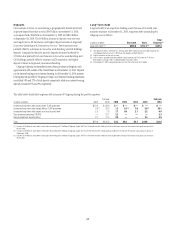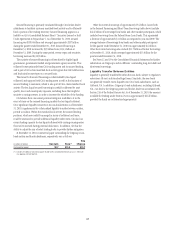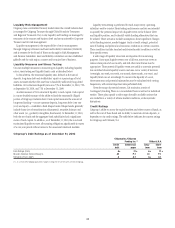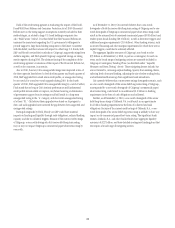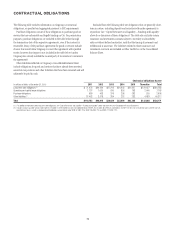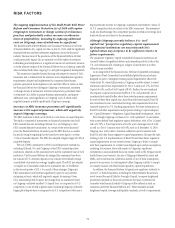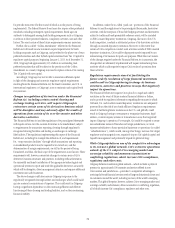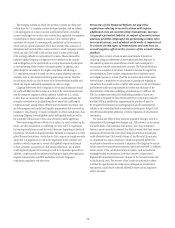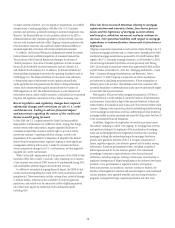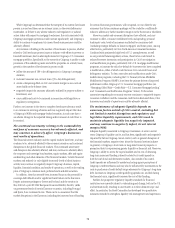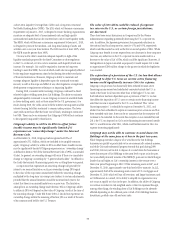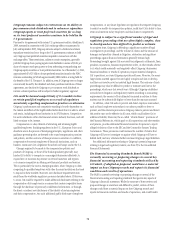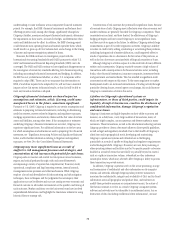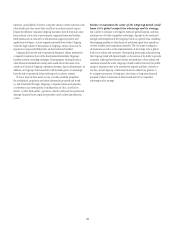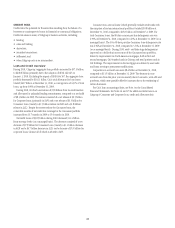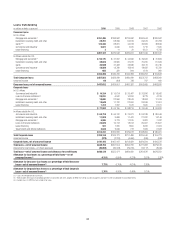Citibank 2010 Annual Report Download - page 77
Download and view the complete annual report
Please find page 77 of the 2010 Citibank annual report below. You can navigate through the pages in the report by either clicking on the pages listed below, or by using the keyword search tool below to find specific information within the annual report.75
is largely uncertain. However, any new regulatory requirements, or modified
interpretations of existing regulations, will affect Citi’s U.S. Consumer
practices and operations, potentially resulting in increased compliance costs.
Moreover, the Financial Reform Act also provides authority to the SEC to
determine fiduciary duty standards applicable to brokers of retail customers.
Any new such standards could also affect Citigroup’s business practices with
retail investment customers and could have indirect additional effects on
standards applicable to business with certain institutional customers.
In addition, the Financial Reform Act fundamentally altered the current
balance between state and federal regulation of consumer financial law.
The provisions of the Financial Reform Act relating to the doctrine of
“federal preemption” may allow a broader application of state consumer
financial laws to federally chartered institutions such as Citibank, N.A.
and Citibank (South Dakota), N.A. In addition, the Financial Reform Act
eliminated federal preemption protection for operating subsidiaries such as
CitiMortgage, Inc. The Financial Reform Act also allows state authorities
to bring certain types of enforcement actions against national banks
under applicable law and granted states the ability to bring enforcement
actions and to secure remedies against national banks for violation of
CFPB regulations as well. This additional exposure to state lawsuits and
enforcement actions, which could be extensive, could subject Citi to increased
litigation and regulatory enforcement actions, further increasing costs.
Recent legislative and regulatory changes have imposed
substantial changes and restrictions on Citi’s U.S. credit
card businesses, leading to adverse financial impact
and uncertainty regarding the nature of the credit card
business model going forward.
In May 2009, the U.S. Congress enacted the Credit Card Accountability
Responsibility and Disclosure Act (CARD Act) which, among other things,
restricts certain credit card practices, requires expanded disclosures to
consumers and provides consumers with the right to opt out of certain
interest rate increases. Complying with these changes, as well as the
requirements of the amendments to Regulation Z adopted by the Federal
Reserve Board to implement them, required Citigroup to invest significant
management attention and resources to make the necessary disclosure,
system and practices changes in its U.S. card businesses, and has negatively
impacted Citi’s credit card revenues.
While Citi has fully implemented all of the provisions of the CARD Act that
have taken effect, the so-called “look-back” rules, requiring a re-evaluation
of rate increases since January 2009, remain to be implemented during 2011,
and could further adversely impact Citi’s credit card revenues.
In addition to any potential ongoing financial impact, the CARD Act has
raised uncertainties regarding the nature of the credit card business model
going forward. These uncertainties include, among others, potential changes
to revenue streams, reduction in the availability of credit to higher risk
populations, and reduction in the amount of credit to eligible populations,
all of which may impact the traditional credit card business model,
including Citi’s.
There has been increased attention relating to mortgage
representation and warranty claims, foreclosure process
issues and the legitimacy of mortgage securitizations
and transfers, which has increased, and may continue to
increase, Citi’s potential liability with respect to mortgage
repurchases or indemnification claims and its foreclosures
in process.
Citigroup is exposed to representation and warranty claims relating to its U.S.
Consumer mortgage businesses and, to a lesser extent, through private-label
residential mortgage securitizations sponsored by Citi’s S&B business. With
regard to the U.S. Consumer mortgage businesses, as of December 31, 2010,
Citi services approximately $456 billion of loans previously sold. During
2010, Citi increased its repurchase reserve from approximately $482 million
to $969 million at December 31, 2010. See “Managing Global Risk—Credit
Risk—Consumer Mortgage Representations and Warranties” below.
Pursuant to U.S. GAAP, Citigroup is required to use certain assumptions
and estimates in calculating repurchase reserves. If these assumptions or
estimates prove to be incorrect, the liabilities incurred in connection with
successful repurchase or indemnification claims may be substantially higher
or lower than the amounts reserved.
With regard to S&B private-label mortgage securitizations, S&B has to
date received only a small number of claims for breaches of representations
and warranties. Particularly in light of the increased attention to these and
related matters, the number of such claims and Citi’s potential liability could
increase. Citigroup is also exposed to potential underwriting liability relating
to S&B mortgage securitizations as well as underwritings of other residential
mortgage-backed securities sponsored and issued by third parties. See Note 29
to the Consolidated Financial Statements.
In addition, allegations of irregularities in foreclosure processes across
the industry, including so-called “robo-signing” by mortgage loan servicers,
and questions relating to the legitimacy of the securitization of mortgage
loans and the Mortgage Electronic Registration System’s role in tracking
mortgages, holding title and participating in the mortgage foreclosure
process, have gained the attention of the U.S. Congress, Department of
Justice, regulatory agencies, state attorneys general and the media, among
other parties. Numerous governmental entities, including a number of
federal agencies and all 50 state attorneys general, have commenced
proceedings or otherwise sought information from various financial
institutions, including Citigroup, relating to these issues. Governmental or
regulatory investigations of alleged irregularities in the industry’s foreclosure
processes, or any governmental or regulatory scrutiny of Citigroup’s
foreclosure processes, has resulted in, and may continue to result in, the
diversion of management’s attention and increased expense, and could result
in fines, penalties, other equitable remedies, such as principal reduction
programs, and significant legal, negative reputational and other costs.


